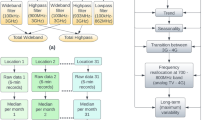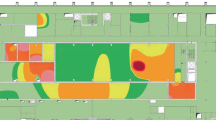Abstract
The design, development, and operation of a network for the monitoring of the non-ionizing electromagnetic radiation in Greece is presented in this paper. Two independent sub-networks, called “Hermes” and “pedion24” have been operating since November 2002 in many areas, and more than 4,000,000 electric field strength measurements have been conducted to date. The measurement results indicate that the non-ionizing electromagnetic radiation levels are several times below the European Commission Recommendation 1999/519/EC and the Hellenic Republic Law no. 3431 reference levels.















Similar content being viewed by others
Notes
The terms uncertainty and error are used interchangeably.
The reason we added GSM-1800 and UMTS 2100 contributions is that in the first model of continuous monitoring stations (EE4070-SL), that was a measured frequency range, and we wanted to directly compare the continuous results to that of ad hoc measurements.
References
European Commission (EC) (1999) Council Recommendation 1999/519/EC of 12 July 1999 on the limitation of exposure of the general public to electromagnetic fields (0 Hz to 300 GHz). Off J Eur Commun L 199, 59 (30 July)
Hellenic Republic Law No. 3431 (2006) About electronic communications and other provisions. Government Gazette, FEK No. 13 A’/ 03.02.
Oliveira C, Sebastiao D, Carpinteiro G, Correia LM, Fernandes CA, Serralha A, Marques N (2007) The monIT Project: electromagnetic radiation exposure assessment in mobile communications. IEEE Antennas and Propagation Magazine 49(1):44–53 (Feb 2007)
“monIT Project web-site”. Electromagnetic radiation monitoring in mobile communications, http://www.lx.it.pt/monit/
“Cassiopea Project”. http://www.stroud.gov.uk/docs/cassiopea/cassiopea.asp
“Progett Gardjola”. http://gardjola.eng.um.edu.mt/emr
“Project Horus”. http://www.projecthorus.com/EMF/
“Hermes” project. A project for systematic measurements of the electromagnetic radiation, http://www.hermes-program.gr
“pedion24” project. A project for continuous measurements of the electromagnetic radiation, http://www.pedion24.ntua.gr
Narda Area Monitor System 2600, “Narda Safety Test Solutions”, http://www.narda-sts.com/en/produkte/2600.htm
PMM 8057 Electric and Magnetic Field Monitoring Station. “PMM Safety Products”, http://www.pmm.it/main/safetyproducts.asp
EE4070, EE4070S, MCE Monitoring System. “E.I.T. s.r.l”, http://www.eitsrl.it/iMCE.htm
Antennessa EMF Measurement Systems, http://www.antennessa.com/emfmeasurementsystems.php
R&S® FSH6 Handheld Spectrum Analyzer. “Rohde-Schwarz”, http://www2.rohde-schwarz.com/
Electronic Communications Committee (ECC) within the European Conference of Postal and Telecommunications Administrations (CEPT): ECC recommendation (02)04 “measuring non-ionising electromagnetic radiation (9 kHz–300 GHz)”
Yalofas A, Gotsis A, Veranopoulos C, Constantinou P, Belesiotis G, Petkaris M, Babalis N (2003) A fully automated and geographically distributed network for the continuous measurement of the RF Radiation—“Hermes” Project. TELSICS, IEEE 6th International Conference on Telecommunications in Modern Satellite, Cable and Broadcasting Services, Niš, Yugoslavia, October
ETSI TR 100 028-1 (2001) Electromagnetic compatibility and radio spectrum matters (ERM): uncertainties in the measurement of mobile radio equipment characteristics; Part 1. v1.4.1, December
ETSI TR 100 028 - 2 (2001) Electromagnetic compatibility and radio spectrum matters (ERM): uncertainties in the measurement of mobile radio equipment characteristics; Part 2. v1.4.1, December
UKAS (2000) The expression of uncertainty in testing, edn 1, October
Vern Lindberg (2000) Uncertainties and error propagation, part I of a manual on uncertainties, graphing, and the Vernier caliper”, http://www.rit.edu/~uphysics/uncertainties/Uncertaintiespart1.html
Gotsis A, Yalofas A, Veranopoulos C, Constantinou P (2003) Design and development of an automated web controlled measurement network for the RF field strength monitoring. IEEE Region 8 EUROCON, The International Conference on Computer as a Tool, Ljubljana, Slovenia, September
Eric W. Weisstein et al. (2005) Normal distribution at MathWorld, (http://mathworld.wolfram.com/NormalDistribution.html). Electronic document, March 20
OriginLab Origin. The nonlinear least squares fitter, fitting results.
Narda Selective Radiation Meter SRM-3000. “Narda safety test solutions”, http://www.narda-sts.com/en/produkte/srm.htm
Gotsis A, Yalofas A, Constantinou P, Boursianis A, Ganatsos T, Tachas N, Samaras T, Daskalou T, Petkaris M (2004) Installation and operation of an EM radiation monitoring network in Greece. Third International Workshop on Biological Effects of Electromagnetic Fields, Kos, Greece, October
Komnakos D, Gotsis A et al (2006) Design, development and operation of an electromagnetic radiation monitoring network in Greece: “Hermes” project. Fourth International Workshop on Biological Effects of Electromagnetic Fields, Crete, Greece, October
Author information
Authors and Affiliations
Corresponding author
Appendices
Appendix 1
Narda SRM-3000 Uncertainty Datasheet
Standard Uncertainty of SRM-3000
Conditions:
Antenna: Triaxial Probe (75–3,000 MHz)
Antenna Cable, 1.5 m
Temperature range, +15°C…+30°C
Uncertainty in (%; as ± values)
Frequency (MHz) | 75–300 | 301–600 | 601–900 | 901–1,200 | 1,201–1,400 | 1,401–1,600 | 1,601–1,800 | 1,801–2,200 | 2,201–2,700 | 2,701–3,000 |
Level measurement accuracy | 8.07 | 8.07 | 8.07 | 8.07 | 8.07 | 8.07 | 8.07 | 8.07 | 12.95 | 12.95 |
Instrument frequency response | 0.33 | 0.33 | 0.33 | 0.33 | 0.33 | 0.33 | 0.33 | 0.33 | 0.33 | 0.33 |
Instrument linearity | 0.00 | 0.00 | 0.00 | 0.00 | 0.00 | 0.00 | 0.00 | 0.00 | 0.00 | 0.00 |
Antenna factor calibration | 6.10 | 9.43 | 9.43 | 9.43 | 9.43 | 9.43 | 6.10 | 6.10 | 6.10 | 6.10 |
Antenna frequency response | 0.33 | 0.33 | 0.33 | 0.33 | 0.33 | 0.33 | 0.33 | 0.33 | 0.33 | 0.33 |
Ellipse radio | 3.42 | 3.42 | 3.42 | 5.57 | 5.57 | 8.94 | 8.94 | 10.88 | 12.89 | 19.26 |
Cable attenuation | 1.16 | 1.16 | 1.16 | 1.16 | 1.16 | 1.16 | 1.16 | 1.16 | 1.16 | 1.16 |
Cable frequency response | 0.33 | 0.33 | 0.33 | 0.33 | 0.33 | 0.33 | 0.33 | 0.33 | 0.33 | 0.33 |
Mismatch antenna–cable | 4.46 | 4.46 | 4.07 | 3.97 | 3.97 | 3.97 | 2.83 | 2.83 | 3.16 | 3.16 |
Mismatch cable–SRM unit | 1.77 | 1.77 | 1.77 | 1.77 | 1.77 | 1.77 | 1.77 | 1.77 | 1.77 | 2.23 |
Mismatch antenna–SRM unit | 11.15 | 10.25 | 8.84 | 8.84 | 8.13 | 8.13 | 5.66 | 5.66 | 5.92 | 7.15 |
rss combined standard uncertainty (%) | 16.2 | 17.2 | 16.3 | 16.8 | 16.5 | 17.9 | 15.1 | 16.3 | 20.5 | 25.4 |
expanded uncertaity (k = 1.96) [%] | 31.8 | 33.7 | 31.9 | 33.0 | 32.3 | 35.1 | 29.5 | 31.9 | 40.2 | 49.7 |
Appendix 2
Safety index measurement uncertainty evaluation
The exposure quotient is defined as \(x = \sum\limits_{i = 75\operatorname{MHz} }^{3\operatorname{GHz} } {\left\{ {\left( {\frac{{E_i }}{{E_{\lim ,i} }}} \right)^2 } \right\}} \), and for an arbitrary frequency i, the following formulas hold: \(E_i \pm \Delta E_i {\text{,}}\), where \(\Delta E_i = E_i \times \delta E_i = E_i \times \sigma _{{\rm E}_i } \)and \({\text{ }}\sigma _{{\rm E}_i } \) is the combined standard uncertainty.
First, we evaluate the uncertainty of the arbitrary term \(\left( {\frac{{E_i }}{{E_{\lim ,i} }}} \right)^2 \) of the sum. We define: \(K_i = \frac{{E_i }}{{E_{\lim ,i} }},\), thus, \(\Delta K_i = \sigma _{{\rm K}_i } = \frac{{\Delta {\rm E}_i }}{{{\rm E}_{\lim ,i} }} = \frac{{\delta {\rm E}_i \times {\rm E}_i }}{{{\rm E}_{\lim ,i} }}\). Next we define \(z = K_i^2 = \left( {\frac{{E_i }}{{E_{o\rho ,i} }}} \right)^2 \), and we evaluate Δz:
where the term \(\left( {\Delta K_i } \right)^2 \)is ignored due to its minor contribution to the sum.
Next, we evaluate the uncertainty of the terms summation by applying the following propagation mechanism.
If x, y, z…are random variables and their uncertainty values are Δx, Δy, Δz…correspondingly, then for the variable α = x + y + z +…we have \(\Delta \alpha = \sqrt {\left( {\Delta x} \right)^2 + \left( {\Delta y} \right)^2 + \left( {\Delta z} \right)^2 + ...} \) Therefore, for the exposure quotient x we have:
Rights and permissions
About this article
Cite this article
Gotsis, A., Papanikolaou, N., Komnakos, D. et al. Non-ionizing electromagnetic radiation monitoring in Greece. Ann. Telecommun. 63, 109–123 (2008). https://doi.org/10.1007/s12243-007-0006-1
Received:
Accepted:
Published:
Issue Date:
DOI: https://doi.org/10.1007/s12243-007-0006-1




